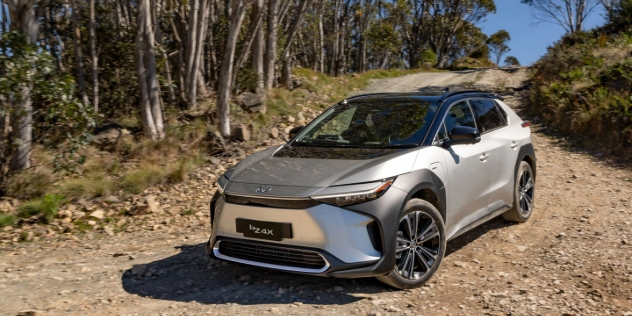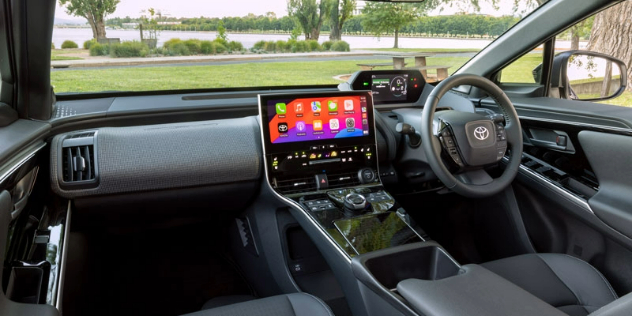Toyota reveals bZ4X pricing hot on heels of Subaru Solterra price drop

Toyota has announced that the bZ4X - set to arrive in Australia in the first half of 2024 - and it is set to take on both the Tesla Model Y and its twin, the Subaru Solterra, which just got an 11 per cent price drop.
With single motor front-wheel drive (FWD) models starting at $66,000, the bZ4X is just $600 more (before on-roads) than the $65,400 Tesla Model Y RWD.
The FWD variant comes with a 150kW motor, producing 266Nm of torque, and is powered by a 71.4kWh battery, which Toyota says will deliver a WLTP range of 436 kilometres - some 19km less than the Tesla's 455km.
The dual motor all-wheel drive kicks off from $74,900, a full $3,500 less than the Model Y Long Range AWD and $5,000 more than the base model AWD Subaru Solterra.
However, while the AWD version of the bZ4X features a dual-motor setup with a total output of 160kW and 337Nm of torque, it delivers just 411 kilometres WLTP range from the same 71.4kWh battery, whereas the Model Y Long Range gets a larger battery and 533km WLTP range.
And whereas the AWD Model Y gets a fast charger speed than the RWD's 170kW, both bZ4X variants support the same 11kW AC and 150kW DC charging capacity, which Toyota says allows a charge time from 10-80 per cent in 30 minutes and full AC charge time in seven hours.

Toyota bZ4X features and specifications
Standard features across both drivetrains include the following:
Mechanical specs:
- 150kW and 266Nm front-mounted electric motor.
- Single-speed front transaxle
- 71.4kWh lithium-ion battery with 436km WLTP range
- Front MacPherson strut and rear multi-link with coil springs suspension
- Ventilated disc brakes and electric power steering
Exterior features:
- Poly-ellipsoidal LED headlights with adaptive high-beam, auto-levelling
- LED tail lamps and a rear fog lamp
- 20-inch alloy wheels
- Privacy windows on the rear side, quarter and back
- Six colour options
- Power tailgate for easy access to the boot
Interior comforts:
- Sport seats with fabric and SofTex® trim, and a 60:40 split-fold rear seats
- Shift-by-wire drive selector and a leather-accented steering wheel
- Dual-zone climate control
- Smart entry and start system, for keyless car access and ignition
- Automatic front wipers and an auto-dimming rear-view mirror
- Adjustable comfort with an 8-way power adjustable driver seat including lumbar support
- Manually adjustable 6-way front passenger seat with heating options
- Tilt-and-telescopic steering wheel adjustment, rear air vents, driver and passenger seatback pockets, and rear seat vertical headrest adjustment
- 4 cupholders and 8 bottle holders, plus a first aid kit and tyre repair kit for on-the-go emergencies
Safety suite:
- Comprehensive suite including pre-collision system, active cruise control, lane trace assist and road sign assist
- Stability control, front and rear parking support brake and sensors, reversing camera
- Seven airbags and vehicle stability control as standard
- Two ISOFIX points and three rear top tether mounts
Connectivity:
- 12-month complimentary subscription for Toyota Multimedia Connect
- 12.3-inch multimedia display with cloud navigation
- A 7.0-inch multi-information display providing essential info
- Full smartphone integration with wireless Apple CarPlay and Android Auto
- 4 USB-C ports and 1 USB-A port
- 12V accessory socket for additional electronic devices
- 6-speaker audio system

The AWD variant gets the following additions:
Mechanical upgrades:
- Dual 80kW motors front and rear, providing a combined output of 160kW and 337Nm
- Adjusted range to 411km (WLTP)
- Exterior additions:
- Roof spoiler and rails
- Panoramic roof
- Memory and reverse auto-adjust side mirrors
- Gloss black bonnet accent
Interior enhancements:
- Premium SofTex® seat trim and a heated steering wheel
- Ventilated front seats
- Qi-compatible 10W wireless charger
- Advanced safety and tech:
- X-Mode for superior off-road capability
- Panoramic view monitor and blind-spot monitor with Safe Exit Assist
- A 9-speaker JBL® premium sound system
In a bid to give drivers the opportunity to try and EV without the full commitment of actually buying it, Toyota has also announced a consumer lease offer. Available for a minimum 36 month term, the lease offer includes all servicing and maintenance, tyres, comprehensive insurance, registration, compulsory third-party insurance, and roadside assistance. Optional extras include accessories and a charge card.
For the battery, the bZ4X gets an eight-year/160,000km warranty for less than 70 per cent state of health.
— Bridie Schmidt
Toyota claims improved battery performance
In Toyota’s last bZ4X announcement it said it had made changes to improve the battery performance of its first fully electric vehicle, which has copped criticism overseas for its slow charge times.
New improvements reportedly include more visibility around state of charge, defaulting the climate control to ECO mode, and prioritising heating of front seats and steering wheel - rather than the whole interior of the car - in cold weather.
One of the key software updates in the latest bZ4X model uses the climate-control system to conserve battery power by automatically defaulting to AUTO (ECO) mode. This adjustment is said to significantly reduce the power drawn from the battery, saving energy for driving instead.
Additional energy savings are realised in cooler weather by prioritising the heating of the front seats and steering wheel, alongside a humidity sensor that more accurately controls the timing of outside air intake to prevent windscreen fogging.
The bZ4X is covered by a five-year unlimited kilometre warranty, extended to seven years on its motor and driveline with log-book services. For the battery, the bZ4X gets an eight-year/160,000km warranty for less than 70 per cent state of health. Capped price $180 servicing takes place every 12 months/15,000km for the first five years.


Subaru drops pricing for Solterra electric SUV
Pricing for Toyota’s first EV comes hot on the heels of news on Friday that Subaru dropped the price of its all-electric SUV by an astonishing 11 per cent ahead of its arrival in coming weeks.
Dubbed the Solterra, Subaru first announced pricing in November 2023 starting at $77,900 for its base AWD option, and $83,690 for the AWD Touring variant (all before on-roads.)
Now, the Japanese carmaker has dropped pricing by a significant $8,000 for the AWD and $6,700 for the AWD Touring, bringing prices down to $69,990 and $76,990 respectively.
Those who have already placed an order will no doubt be pleased to hear they will receive the discounted pricing, as well as the previously announced complimentary five-year service plan and five-year roadside assistance.
In addition to the five-year service plan and roadside assistance, both models come with essential accessories like a carpet mat set, cargo tray, and a 2kW AC charging cable.

Subaru Solterra specifications
At the heart of the Subaru Solterra is a robust 71.4kW lithium-ion battery, propelling the vehicle with a maximum output of 160kW and 337Nm of torque.
The Solterra has an NEDC-rated range of 485km, which in real world terms translates to around 340km in combined city and highway driving.
According to Subaru, charging the Solterra via a rapid DC charge from 0 to 80 per cent can be achieved in about 30 minutes with a 150kW DC charger, while a full charge takes approximately nine and a half hours with a 7kW AC charger.
Inside, a central 12.3-inch high-definition touchscreen offers seamless connectivity with wireless Apple CarPlay and Android Auto, while the choice of a 6-speaker or an exclusive 10-speaker Harman Kardon sound system in the AWD Touring variant ensures an immersive audio experience.
The AWD Touring variant stands out with a panoramic glass sunroof, adding a touch of luxury and openness to the cabin.


Will the Solterra be Australia’s first all-electric off-roader?
The Subaru Solterra is billed as an off-road electric with “engaging driving dynamics” and “diverse terrain capability.”
With considerable ground clearance of 212mm and a “Dual Mode X-Mode" feature to add grip and control in challenging conditions, the inclusion of a new Grip Control function promises to enhance its off-road capability.
It’s no secret that the Subaru Solterra looks very similar to the upcoming Toyota bZ4X; both are the product of a venture between the two Japanese behemoths and are built on a dedicated all-electric platform known as the e-TNGA platform.
The shared platform strategy between Subaru and Toyota is intended to allow both companies to capitalise on their respective strengths: Toyota's expertise in electrification (albeit not true electric, but 20 years' worth of hybrid experience) and Subaru's prowess in AWD technology and safety features.
While the bZ4X is available in rear-wheel and AWD formats, the Solterra is only available in AWD. Whether the Solterra proves to be a capable vehicle both on and off rugged Australian roads will no doubt become apparent soon as press cars make their way to media.
In the meantime, managing director for Subaru Australia Blair Read had this to say of the Solterra in January via a statement: “The smooth, linear output of the dual electric motors combined with Subaru’s legendary Symmetrical All Wheel Drive, means drivers have outstanding control and capability on all kinds of road and conditions."
.jpg)
Two new electric Japanese SUVs coming to Australia market soon
The addition of the Subaru Solterra and Toyota bZ4X to Australia’s EV market is unarguably a significant milestone – one in every five cars sold in Australia is a Toyota, and Subaru is also in the top ten of most sold brands.
But will they have a chance of beating down all-electric experts like Tesla and Chinese EV makers like BYD? Toyota has a record of opposing zero emissions clean transport policy, raising questions about whether it – and by de facto, Subaru – are serious about selling battery electric vehicles.
That said, both the Subaru Solterra and Toyota bZ4X bring four-wheel-drive know-how and a high level of consumer trust that could convince more cautious drivers to consider switching to electric.


